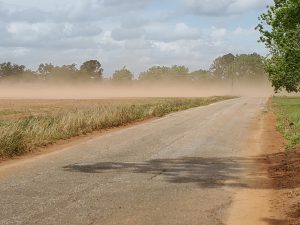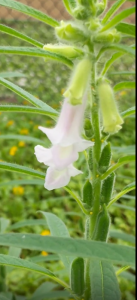Cover crops provide benefits to all types of growers, whether it’s hay production, small or large, fruit or vegetable production, or home gardeners. Additionally, beekeepers can benefit from the use of cover crops since cover crops provide nectar and pollen resources for the honey bees.
This article provides basic information for the reader to understand the connection between soil and crop health. When using cover crops, become familiar with the different types of cover crops for your region by their seasonality. Some will not grow well in the cool weather and some will not grow well in the heat. Also, I would like to encourage the reader to utilize cover crops when possible, to improve poor soil conditions; those lacking drainage especially in the rainy season, those lacking organic material and have excessive drainage, nutrient poor soils, or when growing crops or home gardens. Cover crops can be used during the offseason to condition the soil for your upcoming vegetable garden or agricultural crops.
Benefits

Let’s look at some of the benefits of cover crops. Cover crops improve soil health conditions by decreasing harmful organisms like weed seed, disease pathogens, and nematodes, soil-bound, microscopic roundworms. Nematodes feed on the roots of plants and interfere with water and nutrient uptake. Cover crops reduce the need to till or turn the soil. This, in turn, improves the soil profile. Cover crops increase organic material in the soil which increases soil moisture retention. Some cover crops scavenger nitrogen from the soil and bind the nitrogen to the plant’s roots. Consequentially, the nitrogen will then be available for the next season’s crop, reducing the need for extra fertilizer. Additionally, cover crops reduce soil and wind erosion on barren land or fallow gardens.
Have you ever noticed a dust storm blowing across a road you are traveling? When land is left barren, wind picks up small soil particles and carries them through the air. Have you noticed erosion ditches at the edge of a fallow field created by a heavy rainstorm? The use of cover crops will reduce both of these environmental impacts. And to encourage the use of cover crops, there are several that sprout within days with very little water to promote sprouting.
Some cover crops like radishes improve soil conditions when the root expands the soil. The expansion provides good soil filtration. This is a common trait when using the brassica family of plants.
More benefits…

Cover crops increase plant and animal biodiversity in the landscape, along the perimeter of crop fields, or in backyard garden settings. Pollinators and beneficial insects are attracted to the pollen and nectar, birds and a few mammals are attracted to the seeds, plant, or the habitat provided by the cover crops. Furthermore, cover crops increase crop yields. In a USDA publication, after the first year of planting cover crops, farmers reported an increase in corn and soybean yield by .5% and 2.1%, respectively. After a five-year period, the same crops’ yields increased to 4% and 5%, respectively. Yields improved because of the effects of rainfall infiltration, reduced soil evaporation, and improved soil quality.
Cover crops can be interplanted in your garden or agricultural crops, as well as, around the base of fruit trees. Sunnhemp (Crotalaria spp.) is planted in orange groves between the rows of trees. Sunnhemp provides nectar for pollinators and a source of nitrogen for the trees. Even homeowners can interplant cover crops in their landscape and gardens where soil conditions are poor.
Lastly, cover crops can become cash crops. For example, sunflowers (Helianthus spp.) and sesame (Sesamum indicum) can be cover crops that you turn into cash. When used as a cover crop, they add organic material to the soil, provide pollen and nectar resources, and then the sunflowers and sesame seeds can be harvested at the end of the season and sold at farmer’s markets.
Disadvantages
However, there are some disadvantages to utilizing cover crops. Many like to volunteer or become weedy during the growing season. Additionally, they have uneven growing cycles and growth heights. Matching compatible plants is important, However, this can be difficult, and you may end up creating monocultures of one species, reducing biodiversity. Some cover crops need a large piece of equipment, a roller crimper, to terminate the growing season because of the heartiness or the thickness of the stems. Some lack showy flowers providing nectar and attractiveness, like sorghum, oats, and other grassy cover crops.
As mentioned as a success for increasing crop yields, this is also a disadvantage. To reap the soil quality benefits in order to increase yield, it may take several growing seasons; not good for those necessitating quick soil improvements. Additionally, when you are growing cover crops on a large scale, seed procurement can get very expensive. You can find clover seed selling at $10 per pound. If you lived in the northern parts of US, clover was a weed in your backyard. At $10 per pound for a weed, this may not seem reasonable.

Oh, so beastly
Lastly, some cover crops could be a beauty or a beast. For example, sunnhemp has a beautiful yellow spray of flowers. However, it can grow to seven foot tall, and management is more extensive than other cover crops. Another example is wild mustard (Sinapis arvensis). A field of wild mustard is stunning. On the flip side, wild mustard is very seedy and will be a pest for years to come.
In summary, cover crops provide more benefits than they are misfits. First, determine which benefit you wish to redeem from cover crops, then seek seeds from cover crops that have compatible growing cycles and growth heights. Next month, I will discuss specific groups of cover crops, seasonality, and pictures to identify them.
If you seek more details now, reach out to Lisa Hickey, UF/IFAS Manatee County Extension Agent for Sustainable Food Systems. Lisa.HIckey@ufl.edu or 941-722-4525 extension 1817. Lisa’s webpage: Vegetable and fruit crops
 0
0
